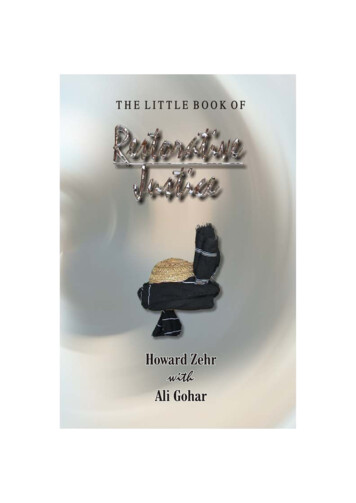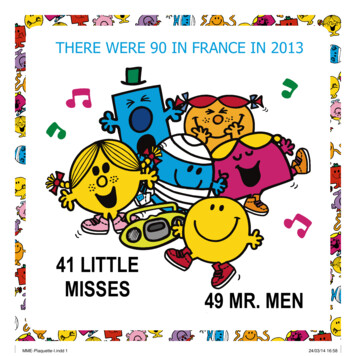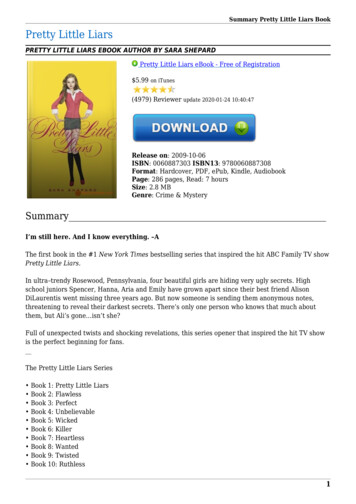
Transcription
Transformationhis base he alsoHe completed hisght Scholar fromhand book by theTHE LITTLE BOOK OF
The authorsHoward Zehr directed the first victim offenderconferencing program in the U.S. and is oneof the developers of restorative justice as aconcept. His book Changing Lenses: A New Focusfor Crime and Justice is considered a classic in thefield. His other publications include Doing Life:Reflections of Men and Women Serving LifeSentences, Transcending: Reflections of CrimeVictims and The Little Book of Restorative Justice.Forthcoming in fall, 2003, is The Little Book ofFamily Group Conferences, New Zealand Style(with Allan MacRae).Dr. Zehr is Co-Director of the graduate Conflict TransformationProgram at Eastern Mennonite University. From this base he alsoteaches and practices in the field of restorativejustice. Zehr received his M.A. from the Universityof Chicago and his Ph.D. from Rutgers University.Ali Gohar worked as Additional CommissionerSocial Welfare Cell for Afghan Refugees forthirteen years. Presently working as ChiefExecutive, Just Peace International inc. forAfghanistan and Pakistan.Ali Gohar received his MSc in InternationalRelations from Quaid-i-Azam university Islamabad . He completed hissecond Master in Conflict Transformation as a Fulbright Scholar fromEastern Mennonite University VA, USA.The Pushto, Urdu and Persian (Dari) version of the hand book by thesame authors are under publications.alibaba1956@hotmail.comPh: 92 - 91 - 5700724T
THE LITTLE BOOK OFRestorativeJusticeHoward ZehrwithAli Gohar
AcknowledgmentAspecial thanks to the many friends and colleagues who gave mefeedback on this manuscript. We also wish to thank Good Books,who published The Little Book of Restorative Justice, for theirpermission to release the manuscript in this form which was madepossible by Uni-Graphics Peshawar. They took care of all the stagesfrom typing to the production of this book on a no-profit basis.Information about Good Books and their publications is availablefrom www.goodbks.com while information about Uni-Graphics can beobtained from unigraphicspsh@yahoo.com.
Table of Contents1.2.Preface1An Overview2Why this Little Book?4Restorative justice is not.6Restorative justice is concerned about needs and roles11Restorative Principles17Three pillars of restorative justice21The “who” and “how” are important24Restorative justice aims to put things right27A restorative lens32Five principles of restorative justice33Defining restorative justice39The goals of restorative justice40Guiding questions of restorative justice41Restorative justice signposts43
3.4.Restorative Practices45Core approaches often involve an encounter47Models differ on the “who” and “how”49Models differ on their goals53A restorative continuum55Is it Either/Or?59Retributive justice vs. restorative justice?59Criminal justice vs. restorative justice?60Restorative justice is a river62Conflict transformation of restorative justice65Appendix82Fundamental principals of restorative justice82Selected Reading88Related books by this author89
PrefaceThe original version of The Little Book of Restorative Justice1 waswritten primarily for a North American audience. As Ali Goharand I began to work together, he felt that the book would havevalue in his home context not as a blueprint to be implemented there,but as a catalyst for a discussion about justice and values in thePakistani-Afghan context.To simply present the book as originally written did not seemquite appropriate for this purpose. However, to try to fully adapt itwould probably result in something artificial and inappropriate aswell. We concluded that it was best to acknowledge the book for whatit was originally intended, but make some adaptations and additionalcommentary for the Pakistani-Afghan audience.I have, therefore, in collaboration with Ali Gohar made onlyminor changes in the primary text. We have then inserted Ali'scommentary or additions in boxes with italicized text.I am pleased to have this opportunity to be part of what I hopewill be a multi-directional dialogue about justice. It is throughsharing ideas that we learn and grow. Indeed, some of Ali'ssuggestions have caused me to modify some of my own basic concepts.In that sense, my willingness to share this material is some whatselfish: I have much yet to learn.As I told an international audience recently, we are all on ajourney here. The road to a justice that restores is long, with manycurves, dead-ends and unknowns. Moreover at least in the West weare very early on this journey. We need all the help from each otherthat we can get.SalaamDr. Howard Zehr October, 20031Published by Good Books, Intercourse, Pennsylvania, USA - See www.goodbooks.com1
1An OverviewHow should societies respond to wrongdoing? When a crimeoccurs or an injustice is done, what needs to happen? Whatdoes justice require?Whether we are concerned with crime or other offenses, thewestern legal system has profoundly shaped our thinking about theseissues - not only in the western world but in much of the rest of theworld as well.The western legal or criminal justice system's approach to justicehas some important strengths.Yet there is also a growingacknowledgment of this system's limits and failures. Victims,offenders and community members often feel that justice does notadequately meet their needs. Justice professionals - judges, lawyers,prosecutors, probation and parole officers, prison staff - frequentlyexpress a sense of frustration as well. Many feel that the process ofjustice deepens societal wounds and conflicts rather thancontributing to healing or peace.Restorative justice is an attempt to address some of these needsand limitations. Since the 1970s, a variety of programs andapproaches have emerged in thousands of communities and manycountries throughout the globe. Often these are offered as choiceswithin or alongside the existing legal system. Starting in 1989,however, New Zealand has made restorative justice the hub of itsentire juvenile justice system. Whether it will live up to this promiseremains to be seen but in many circles today, restorative justice isconsidered a sign of hope and the direction of the future.2
An Over ViewRestorative justice began as an effort to deal with burglary andother property crimes that are usually viewed (often incorrectly) asrelatively minor offenses. Today, however, restorative approaches areavailable in some communities for the most severe forms of criminalviolence: death from drunken driving, assault, rape, even murder.Building upon the experience of the Truth and ReconciliationCommission in South Africa, efforts are also being made to apply arestorative justice framework to situations of mass violence.These approaches and practices are also spreading beyond thecriminal justice system to schools, to the workplace and religiousinstitutions. Some advocate the use of restorative approaches such ascircles as a way to work through, resolve and transform conflicts ingeneral. Others pursue circles or “conferences” as a way to build andheal communities. Kay Pranis, a prominent restorative justiceadvocate, calls circles a form of participatory democracy that movesbeyond simple majority rule.In societies where western legal systems have replaced and/orsuppressed traditional justice and conflict-resolution processes,restorative justice is providing a framework to re-examine andsometimes re-activate or adapt these traditions.Punchayat in the Sub-continent and jirgah in pukhtooncommunities are traditional circle approaches that show muchpromise from a restorative perspective.Although the term “restorative justice” encompasses a variety ofprograms and practices, at its core it is a set of principles, a philosophy,an alternate set of “guiding questions.” Ultimately restorativejustice provides an alternative framework for thinking aboutwrongdoing. In an earlier book, I called this “changing lenses.”22Changing Lenses: A New Focus for Crime & Justice (Scottdale, PA, USA: Herald Press, 1990/95)3
The Little Book of Restorative JusticeWhy this little book?This Little Book does not try to make the case for restorativejustice. Nor does it try to explore the many implications of thisapproach. Rather, this book is intended as a brief description oroverview of restorative justice. Although it will outline some of theprograms and practices of restorative justice, the focus of this book isespecially on the principles or philosophy of restorative justice.The Little Book of Restorative Justice is intended for those whohave heard the term and are curious about what it implies. It is alsointended for those who are involved in the field but are unclear orlosing track of what they are about. It is a small effort to help bringclarity about where the restorative justice “train” should be headedand, in some cases, to nudge the train back onto the track.Such an effort is important at this time. Like all change efforts,as restorative justice has developed and spread, it has sometimes lostits way. With more and more programs being termed “restorativejustice,” its meaning often has been diluted or confused. Under theinevitable pressures of working in the real world, restorative justicehas sometimes been subtly co-opted or diverted from its principles.The victim advocacy community has been especially concernedabout this. Restorative justice claims to be victim-oriented, but is it inreality? All-too-often, victim groups fear, restorative justice effortshave been motivated mainly by a desire to work with offenders in amore positive way. Like the criminal system it aims to improve orreplace, restorative justice may become primarily a way to deal withoffenders.Others wonder whether the field has adequately addressedoffender needs from a restorative perspective. Do restorative justiceprograms give adequate support to offenders to carry out theirobligations and to change their patterns of behavior? Do theyadequately address the harms that may have led offenders to becomewho they are? Are such programs becoming just another way to4
An Over Viewpunish offenders under a new guise? And what about the community:is it being adequately encouraged to be involved and to assume itsobligations to victims, to offenders, to its members in general?Past experience of change efforts in the justice arena warns usthat sidetracks and diversions inevitably happen in spite of the bestintentions. If change advocates are unwilling to acknowledge andaddress these diversions, their efforts may end up much differentthan intended. In fact, their “improvements” can turn out to beworse than the conditions that they were designed to reform orreplace.One of the most important safeguards against these sidetracks isattention to core principles. If we are clear about principles, if wedesign our programs with principles in mind, if we are open to beingevaluated by these principles, we have much greater possibilities forstaying on track.Put another way, the field of restorative justice has grown sorapidly and in so many directions that it is sometimes difficult toknow how to move into the future with integrity and creativity. Only aclear vision of principles and goals can provide the compass we need aswe find our way along a path that is inevitably winding and unclear.This book is an effort to articulate the restorative justice conceptin straightforward terms. However, I must acknowledge certainlimits to the framework I will lay out here. I am often considered oneof the founding developers and advocates of this field; even though Ihave tried hard to remain critical and open, I come with this bias.Moreover, in spite of all efforts to the contrary, I write from my own“lens,” and that is shaped by who I am: a white middle-class male ofEuropean ancestry, a Christian, a Mennonite. This biography andthese (as well as other) interests necessarily shape my voice andvision. Also, even though there is a something of a consensus withinthe field on the broad outline of these principles of restorative justice,not all of what follows is uncontested. So what follows is my “take” onrestorative justice; it must be tested against the voices of others.5
The Little Book of Restorative JusticeAlthough Ali and I have made some minor adaptations in thisedition, and Ali has inserted additional commentary in italicizedboxes, we also recognize that this book was originally written in aNorth American context. The terminology, the issues raised, even theway the concept is formulated reflect to some extent the realities ofthis setting.With this background and qualifications, then, what isrestorative justice? So many misconceptions have grown up aroundthe term that I find it increasingly important to first clarify what, inmy view, restorative justice is not.Restorative justice is not.!Restorative justice is not primarily about forgivenessor reconciliation.Some victims and victim advocates react negatively torestorative justice because they have the impression that the goalof such programs is to encourage or even coerce them to forgive orreconcile with offenders.As we shall see, this is not a primary principle or focus ofrestorative justice.It is true that restorative justice doesprovide a context where this might happen. Indeed, some degreeof forgiveness or even reconciliation does occur much morefrequently than in the adversarial setting of the criminal justicesystem. However, this is a choice that is entirely up to theparticipants. There should be no pressure to choose this option.In “high context” or communal settings, processes of forgivenessare more often central to resolve the wrong. The offender is forgivenwith the help of community elders. Governments then usuallyrespect these decisions of the victim and the community. In thewestern legal system, however, forgiveness processes are more6
An Over Viewsideline to justice and offenders are usually required to completetheir punishment even if forgiven.Although there is a phrase “forgive and forget” in westernculture, many teach that forgiving does not involve forgetting:“remember and forgive,” some say. In Eastern culture, forgivenessand reconciliation often do require one to forget.!Restorative justice is not mediationLike mediation programs, many restorative justice programs aredesigned around the possibility of a facilitated meeting orencounter between victims, offenders and perhaps communitymembers. However, an encounter is not always chosen orappropriate. Moreover, restorative approaches are importanteven when an offender has not been apprehended or when a partyis unwilling or unable to meet. So restorative approaches are notlimited to an encounter.Even when an encounter occurs, the term “mediation” is aproblematic description. In a mediated conflict or dispute,parties are assumed to be on a level moral playing field, oftenwith responsibilities that may need to be shared on all sides.While this sense of “shared blame” may be true in some criminalcases, in many cases it is not. A victim in a rape or even aburglary does not want to be known as a “disputant.” In fact,they may well be struggling to overcome a tendency to blamethemselves.At any rate, to participate in most restorative justice encounters,a wrongdoer must admit to some level of responsibility for theoffense, and an important component of such programs is toname and acknowledge the wrongdoing. The neutral language ofmediation may be misleading and even offensive in such cases.Although the term “mediation” was adopted early on in the field,for the above reasons it is increasingly being replaced by theterms such as “conferencing” or “dialogue.”7
The Little Book of Restorative Justice!Restorative justice is not primarily designed to reducerecidivismIn an effort to gain acceptance, restorative justice programs areoften promoted or evaluated as ways to reduce repeat crimes.There are good reasons to believe that in fact such programs willreduce offending. Indeed, the research thus far centeringmainly on juvenile offenders is quite encouraging on this issue.Nevertheless, reduced recidivism is not the reason for operatingrestorative justice programs. Reduced recidivism is an expectedbyproduct, but restorative justice is done first of all because it isthe right thing to do: victims' needs should be addressed,offenders should be encouraged to take responsibility, thoseaffected by an offense should be involved in the process,regardless of whether offenders “get it” and reduce theiroffending.In many high context cultures, crime is considered first of all to bea violation of traditional law and of religious values. Communityelders may establish the offender's obligations even if he himself doesnot accept them. The rules governing this may be written but mayalso be an unwritten code.!Restorative justice is not a particular program or ablueprintVarious programs embody restorative justice in part or in full.However, there is no “pure” model that can be seen as ideal orsimply implemented in any community. We areRestorativestill on a steep learning curve in this field; the mostJustice isexciting practices that have emerged in the pastyears were not even on the “screen” of those of usa compasswho began the first programs, and many more newnot a mapideas will surely emerge through dialogue andexperimentation. Also, all models are to some8
An Over Viewextent culture-bound. So restorative justice should be build fromthe “bottom up,” by communities in dialogue andexperimentation. Also, all models are to some extent culturebound. So restorative justice should be build from the “bottomup,” by communities in dialogue assessing their needs andresources and applying the principles to their own situations.Restorative justice is not a map but the principles of restorativejustice can be seen as a compass pointing a direction. Atminimum, restorative justice is an invitation for dialogue andexploration.In traditional societies, however, restorative justice may beembedded in a complete verbal code of life.!Restorative justice is not primarily intended for“minor” offenses or first-time offendersIt may be easier to get community support for programs thataddress such cases. However, experience has shown thatrestorative approaches may have the greatest impact in moresevere cases. Moreover, if the principles of restorative justice aretaken seriously, the need for restorative approaches is especiallyclear in severe cases. The “guiding questions” of restorativejustice may help to tailor justice responses in very difficultsituations. Domestic violence is probably the most problematicarea of application and here great caution is advised.!Restorative justice is not a new or North Americandevelopment.The modern field of restorative justice did develop from caseexperiments in several Mennonite communities in the 1970s.Seeking to apply their faith as well as their peace perspective tothe “real world” of criminal justice, Mennonites and otherpractitioners in Ontario, Canada, and later in Indiana, U.S.A.,experimented with victim-offender encounters that led to9
The Little Book of Restorative Justiceprograms there and became models for programs throughout theworld. Restorative justice theory developed initially from thispractice.However, the movement owes a great debt to earlier movementsand to a variety of cultural and religious traditions. It owes aspecial debt to the Native people of North America and NewZealand. The precedents and roots of this movement are muchwider and deeper than the Mennonite-led initiatives of the 1970s.Indeed, they are as old as human history.In some parts of the world, modern government structures havetaken away from communities the power to resolve disputes andwrongdoing. Yet, in many places, traditional structures are stillworking effectively. In the tribal arrangements of some areas, forexample, major crimes are settled by community elders and familyproblems are effectively resolved by family elders, male and female.!Restorative justice is neither a panacea nor necessarilya replacement for the legal systemBy no means is restorative justice an answer to all situations.Nor is it clear that it should replace the legal system, even in amore-or-less ideal world. Many feel that even if restorativejustice could be widely implemented, some form of the westernlegal system (ideally, a restoratively-oriented one) would beneeded as a backup and as guardian of basic human rights.Indeed, this is the function that the youth courts play in therestorative juvenile justice system of New Zealand.Most restorative justice advocates agree that crime has not only apublic dimension but also a “private” dimension; moreaccurately, this might be termed a societal dimension as opposedto a more local and personal dimension. The legal system focuseson the public dimensions, i.e. on society's interests andobligations as represented by the state. However, this approach10
An Over Viewdownplays or ignores the personal and interpersonal dimensionsof crime. By focusing on and elevating the latter “private”dimensions of crime, restorative justice seeks to provide a betterbalance in how we experience justice.!Restorative justice is not necessarily the opposite ofretributionFor those who are acquainted with my earlier book, ChangingLenses, this may come as a surprise. The contrasting models thatI outlined there retributive justice vs. restorative justice havebeen widely adopted in the field. Those charts remain a usefulanalytical or critical tool, but on the philosophic or theoreticallevel, I no longer see restoration as the polar opposite ofretribution. More on that later.Restorative justice is concernedabout needs and rolesThe restorative justice movement originally began as an effort torethink the needs and roles implicit in crimes. It was concerned aboutneeds that were not being met in the usual western justice process.Those involved in this movement were also concerned that theprevailing understanding of legitimate participants or“stakeholders” in justice was too restrictive. Restorative justiceexpands the circle of stakeholders those with a stake or standing inthe event or the case beyond just the government and the offender toalso include victims and community members.In high context cultures, family members and sometimes evencommunity elders may take the responsibility for making thingsright. They may also take responsibility for offender's and victim'srehabilitation and for reconciliation between families.11
The Little Book of Restorative JusticeBecause this analysis of needs and roles was the origin of thismovement and because the needs/roles framework is so basic to theconcept, it is important to start there. As the field has developed, this“stakeholder analysis” has become more complex and encompassing.The following discussion is limited to some of the core concerns thatwere present at the beginning of the movement and continue to play acentral role. It is also limited to “judicial” needs: those needs ofvictims, offenders and community members that might be met, atleast partially, through the justice process.The following analysis examines the “judicial needs” of victims,offenders and communities by comparing it to the failures of thewestern legal system. Because they are by nature more restorative,traditional systems often address these needs more effectively.For example, in these contexts where elders oversee the process,the community supports and empowers the victim, providing themwith information and safety. Victims and offenders are bothencouraged to tell their stories and elders investigate the situation toidentify root causes.Offenders or their families are encouraged to come forward andto take responsibility to compensate the family of those victimized.The community also takes responsibility for the rehabilitation andreintegration of both offender and victim.VictimsOf special concern to restorative justice are the needs of crimevictims that are not being adequately met by the criminal justicesystem. Victims often feel ignored, neglected, or even abused by thejustice process. This results in part from the legal definition of crime,which does not include victims: crime is defined as against the state,so the state takes the place of the victim. Yet victims often have anumber of specific needs from a justice process.12
An Over ViewDue to the legal definition of crime and the nature of thecriminal justice process, the following four types of needs seem tobe especially neglected:1.Information. Victims need answers to questions theyhave about the offense, why it happened and what hashappened since. They need “real” information, notspeculation or the legally-constrained information thatcomes from a trial or plea agreement. Often this requiresdirect or indirect access to offenders who hold thisinformation.2.Truth-telling. An important element in healing ortranscending the experience of crime is an opportunity totell their story of what happened. Indeed, it is oftenimportant to retell this many times. There are goodtherapeutic reasons for this: part of the trauma of crime isthe way it upsets our views of ourselves and our world, ourlife-stories. Transcendence of this experience means “restorying” one's life by telling the story in significant settings,often where it can receive public acknowledgment. Often tooit is important for them to tell this story to the ones whocaused this harm and to have them understand the impact oftheir actions.Three day mourn in case of death is a good example, when thesecondary victim tells the story to any new comer and feel themselvesright.3.Empowerment. Victims often feel like control has beentaken away from them by the offense control over theirproperty, their body, their emotions, their dreams.Involvement in their own case as it goes through a justiceprocess can be an important way to return a sense ofempowerment to them.4.Restitution or vindication. Restitution by offenders isoften important to victims, sometimes because of the actual13
The Little Book of Restorative Justicelosses but just as importantly, because of the symbolicstatement implied. When an offender makes an effort tomake right the harm, even if only partially, it is a way ofsaying “I am taking responsibility, and you are not to blame."Restitution, in fact, is a symptom or sign of a more basicneed, the need for vindication. While the concept ofvindication is beyond the scope of this booklet, I amconvinced that it is a basic need that we all have when we aretreated unjustly. Restitution is one of a number of ways ofmeeting this need to even the score. Apology may alsocontribute to this.The theory and the practice of restorative justice have emergedfrom and been profoundly shaped by an effort to take these needs ofvictims seriously.OffendersA second major area of concern that gave rise to restorativejustice is offender accountability.The criminal justice system is concerned about holding offendersaccountable but what is meant is making sure offenders get thepunishment they deserve. Little in the process encourages offendersto understand the consequences of their actions or to empathize withvictims. On the contrary, the adversarial game requires offenders tolook out for themselves.Offenders are discouraged fromacknowledging their responsibility and are given little opportunity toact on this responsibility in concrete ways. The “neutralizingstrategies” the stereotypes and rationalizations that offenders oftenuse to distance themselves from the people they hurt are neverchallenged. Unfortunately, then, the sense of alienation from societyfelt by many offenders is only heightened by the legal process and bythe prison experience. So for a variety of reasons the legal processtends to discourage responsibility and empathy on the part ofoffenders.Restorative justice has brought an awareness of the limits andnegative byproducts of punishment. Beyond that, however, it has14
An Over Viewargued that punishment is not real accountability. Realaccountability involves facing up to what one has done: it meansencouraging offenders to understand the impact of their behavior the harms they have done - and to take steps to put things right asmuch as possible. This accountability, it is argued, is better forvictims, better for society, better for offenders.Offenders have other needs beyond their responsibilities tovictims and communities. If we are to expect them to assume theirresponsibilities, to change their behavior, to become contributingmembers of our communities, restorative justice assumes that theseneeds must be addressed as well. This subject is beyond the scope ofthis little book but the following is suggestive of the areas of need:Offenders need from justice:1.Accountability that! addresses the resulting harms,! encourages empathy and responsibility,! and transforms shame.32.Encouragement to personal transformation,including! healing for the harms that contributed to offendingbehavior,! opportunities for treatment for addictions and/or otherproblems,! enhancement of personal competencies.3.Encouragement and support for integration into thecommunity.4.For some, at least temporary restraint.3Shame theory, though controversial, has emerged as an important topic in restorative justice.In his pioneering book, Crime, Shame and Reintegration (Cambridge, UK, John Braithwaiteargues shame that stigmatizes pushes people toward crime. Shame may be "reintegrative,"however, when it denounces the offense but not the offender and opportunities are provided forthe shame to be removed or transformed.15
The Little Book of Restorative JusticeCommunityCommunity members have needs arising from crime and theyhave roles to play. Restorative justice advocates such as Judge BarryStuart and Kay Pranis argue that when the state takes over in ourname, it undermines our sense of community.4 Communities areimpacted
Three pillars of restorative justice 21 The "who" and "how" are important 24 Restorative justice aims to put things right 27 A restorative lens 32 Five principles of restorative justice 33 Defining restorative justice 39 The goals of restorative justice 40 Guiding questions of restorative justice 41 Restorative justice signposts 43,











